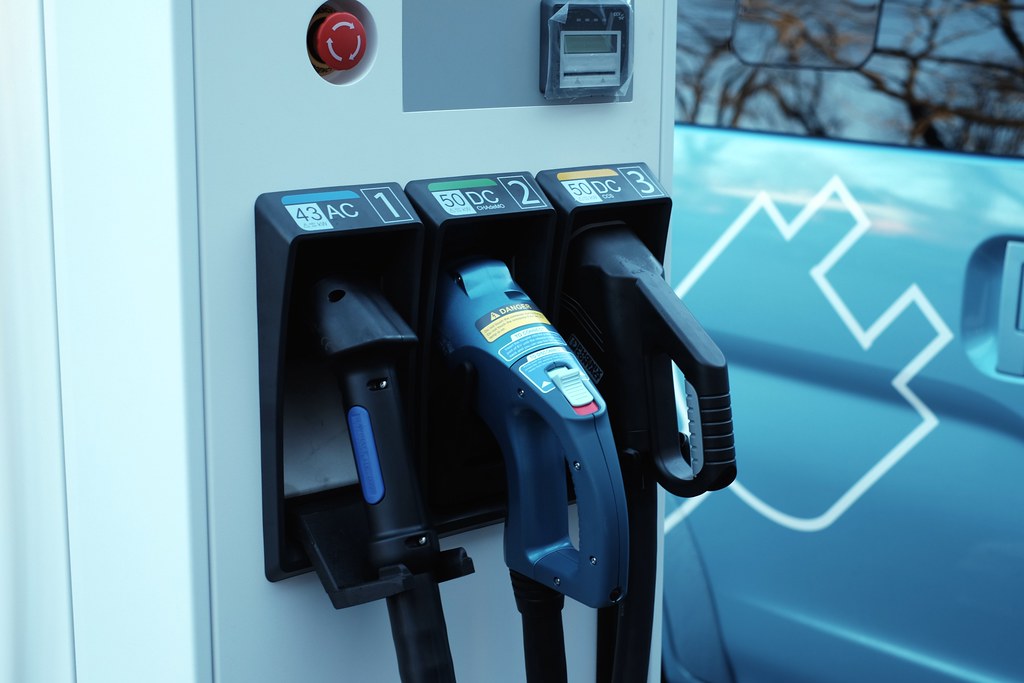Reprinted with permission. This story first appeared on Medium at this link.
Few narratives in the last decade have generated as much momentum as that of electric vehicles. They’ve been heralded as a revolution. Saviors to our gasoline addiction and warriors in the fight for a more sustainable world. Federal departments have noted they have the potential to dramatically improve public health and reduce ecological damage. Financial observers have christened EVs as the next frontier for outsized opportunity and returns. To be seen in one is the ultimate status symbol, signifying that you’re not only someone, but someone who cares about the world, and how the world thinks of you. And that’s something.
Pledges have been made, billions have been allocated from legacy manufacturers, and dozens of startups have been launched with the aim of capturing billions more. It seems that widespread adoption of electric vehicles is all but an inevitability. As we move toward this future, then, it’s important to consider the implications this has, and whether or not leaning so blindly into electric vehicles is really a good thing.
This isn’t a story about Elon Musk, or Tesla, or a contrarian take about how “oil is good, actually.” I unconditionally support electric vehicles in their quest to take over the primacy of gasoline-powered vehicles in the market. But I don’t save that enthusiasm for their prospects on society broadly. From the perspective of the built environment, there is nothing functionally different between an electric vehicle and a gasoline propelled one. The relationship is the same, and it’s unequivocally destructive. Cars, however they’re powered, are environmentally cataclysmic, break the tethers of community, and force an infrastructure of dependency that is as financially ruinous to our country as it is dangerous to us as people. In order to build a more sustainable future and a better world for humanity, we need to address the root problems that have brought us to where we so perilously lie today.
Gasoline-Powered v. Electric Vehicles: The False Fight
Electric vehicles are undeniably superior to their gasoline-powered cousins when considering their emissions impact. EVs have been found to emit almost three times less carbon dioxide during their lifecycle than regular cars (~4,100 lbs of CO2 v. ~11,500 lbs), with further gains in areas with heavier shares of power coming from renewable resources, like California. This is important in reducing our national carbon footprint, for which transportation makes up 29 percent of all emissions. Within transportation, 60 percent of US emissions come from private vehicles that aren’t medium & heavy duty trucks, and more than 80 percent when factoring in the trucks. Certainly, electric vehicles can meaningfully reduce our emissions through capturing a higher share of the market.
While there are qualifiers as to just how clean (and ethical) the production of electric vehicles is, net-net, they are still far better for the environment gasoline-powered cars. Optimistically, EV capture of the total auto market share is trending in the right direction. 3.2 percent of all cars sold globally in 2020 were electric (2.3 million total cars). The market could reach 145 million vehicles by 2030, and potentially upwards 1/3 of all car sales.
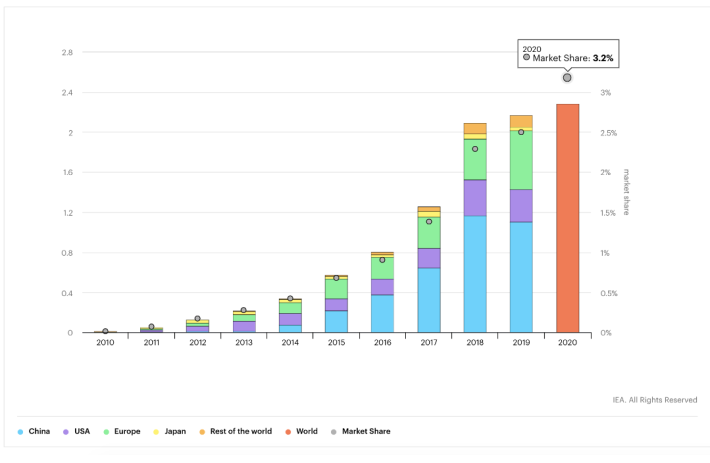
But just as the total market for electric vehicles is growing, so too is the total market for cars. By 2035, nearly 2 billion cars will be on roads around the world. This presents significant challenges. In 2010, 14 percent of the world’s emissions came from transportation. Total emissions have continued to rise in the last decade, with transportation’s share increasing commensurately. This is important because if we want to limit global warming to the critical threshold of 1.5 degrees, we’ll have to reduce total emissions by 55 percent by 2030. If we don’t, we’re on track to see global temperatures rise at least 2 degrees or more, on average. While a world 1.5 degrees warmer is still an existential threat for many, scientists warn that any greater increase could present irreversible change and unimaginably horrific consequences, like mass water shortages, famines, more intense natural disasters, and political instability among other horrors. Unfortunately, time is against us. Our window of opportunity may only be as short as this decade, the 2020s.
Even if every single car were electric by 2030, and all production was carbon neutral (which isn’t possible), we would only reduce global emissions somewhere between 15–20 percent — far short of the estimated 55 percent we need to cut. While the reduction would be greater in the U.S. as transportation comprises a higher proportion of our emissions than at a global level, it still isn’t enough. Carbon emissions care little for international borders.
Coverage of EVs often frames the discussion of sustainability exclusively as electric cars versus gasoline powered cars, but this isn’t the dichotomy to analyze. Instead, we must look to carbon-intensive development patterns versus sustainable development patterns. This distinction is key, as development patterns not only include the total emissions impact of cars, but also that of new construction, existing buildings, infrastructure development, and subsequent deforestation and propagation of carbon intensive lifestyles. All told, property operations and construction account for nearly 50 percent of global carbon dioxide emissions. When combined with transportation emissions (which dictate or depend on our development patterns), the total impact of our built environment stretches far beyond the 55 percent reduction threshold. Indeed, it’s been estimated that metropolitan regions alone account for 70 percent of total energy and greenhouse-gas emissions.
The challenge we’re faced with is clear: We not only have to transition to cleaner vehicles, but we have to transition toward cleaner built environments, generally. Simply transitioning to electric vehicles does nothing to address the underlying cause for our unsustainable living patterns in which private vehicles are the default mode of moving from place to place. Enough false dichotomies, let’s get to the real challenge.
Cars v. The Environment: The Real Fight
Cars need roads to drive on. This much is obvious. But what’s less obvious is the extent to which roads (and cars) dictate how our built environment is constructed. In short, we’ve created a world that’s built around cars first, with people, the environment, natural wildlife, the atmosphere, and practically everything else second. In deciding to build for cars first, we’ve forfeited much of our urban areas to them. Through streets, interchanges, parking lots, and other infrastructure, it’s not uncommon for American downtowns to allocate 50 percent or more of their land to cars. Even Washington, a place many consider walkable and “people-first,” dedicates more than 40 percent of its land to cars. That’s land that could otherwise be housing, parks, cultural venues, or practically anything else but car space (which is agnostic to power source).
Paved areas dedicated to cars absorb heat. According to research from Climate Central, daytime temperatures can be 15 to 27 degrees warmer in cities than in surrounding rural areas due to heat absorption. This effect is exaggerated by the destruction of vegetation (for car-space) that provides natural cooling through evapotranspiration. This whole process is known as the urban-heat-island effect. It can have devastating impacts, from increasing heat related deaths (which totaled 10,500 deaths in the U.S. from 2004–2018), to heightening the impacts of climate change through increased energy consumption (i.e., air conditioners on max power for days at a time).
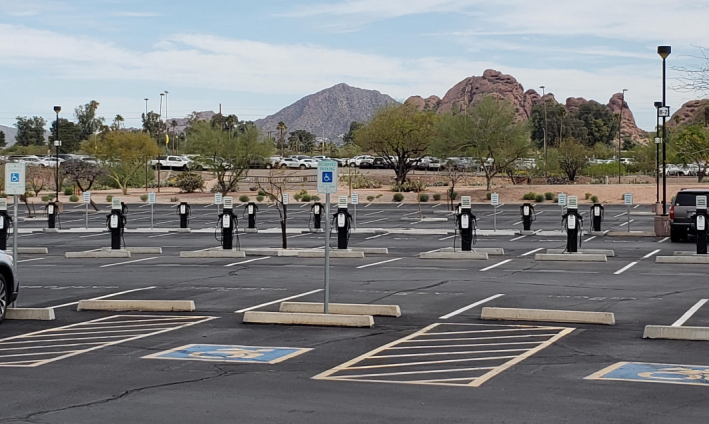
Car-first built environments aren’t exclusive to cities. In the suburban areas that developed following the passage of the Federal Aid Highway Act of 1956, communities were built entirely around the car. Part of the reason was to attract as much federal funding as possible, as entire neighborhoods were subsidized through the construction of single family homes by the FHA. This incentivized suburban development on cheap land near the newly built highways. But a non-insignificant reason developers built so many car-dependent communities was that they conveyed a powerful status symbol for those who lived there, even if they only had modest means. Mid-century subdivisions signaled that the people who lived there had escaped the hustle and grind of the city, and bent the environment to their will to live a fully modernized life. The realization of the American Dream. In driving cars through newly conquered lands, Americans were making a statement that they were someone. And that’s something. This subsidized entitlement to land facilitated by private vehicles has become ingrained in our national ethos.
This ethos has consequences. In 1950, U.S. farm land peaked at 1.2 billion acres. Today, there’s less than 900 million acres. Much of this land has been lost to sprawling development patterns, whereby low-density housing oozes outwards from an urban periphery into previously undeveloped rural land. This pattern is enabled through seemingly bottomless highway funds and prevailing regulatory codes like zoning.
Lot size minimums further incentivize the depletion of open land. They work like this. Municipalities mandate the minimum plot size for every parcel in a neighborhood or a city. These mandates are usually anywhere from an eighth of an acre (in more dense areas), to 10 acres or more in “agriculture-residential” districts. In practice, instead of a 50-unit apartment complex built on a half of an acre, lot size minimums can mandate those 50 homes each be sited on at least one acre of land, causing the development to stretch well over 50 acres when including the requisite roads. This process has been repeated across millions of acres, and has effected tens of millions of people. The impact on climate change from these development processes is substantial, exaggerating the already disproportionately high emissions per capita of residents of sprawling single family homes compared to other housing types.
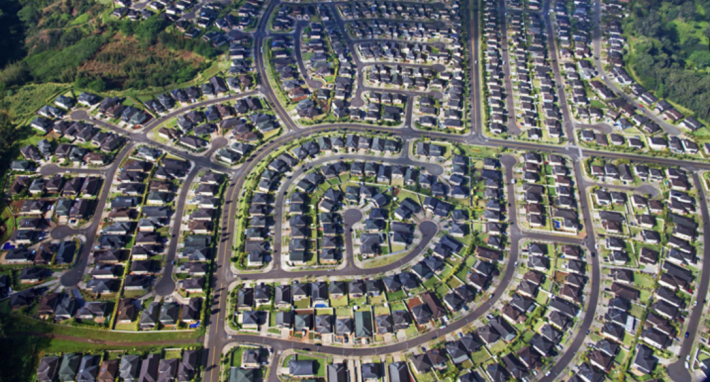
As subdivisions expand outwards and get larger, they’re also increasingly further from essential services like schools, grocery stores, and doctors offices. This fosters a dependency on cars. As people are pushed further out, ever more carbon dioxide is released through new development, vehicle emissions and infrastructure construction, while less carbon dioxide is captured from the plants and vegetation that are cleared from development.
This is a self-reinforcing system. If one lives 45 minutes away from an urban center, and there isn’t any public transport close by, there’s no choice but to drive everywhere. Housing markets respond by building more car dependent patterns, bolstered by regulations and the perceived demand of driving, which is in actuality only a means of last resort. Indeed, by 2017, 87 percent of all trips were taken by car in the United States, despite more than half of the trips being less than three miles. This is well within biking range. What’s more, nearly a third of all trips made were within a mile, comfortably within walking distance. But because of our development patterns, these trips must be made by cars. It isn’t possible to move any other way practicably or safely.
It would be generous to say that this pattern is environmentally cataclysmic. As sprawl stretches out, it clears rural land and forests, and replaces them with heat absorbing asphalt and impervious surfaces that lead to water pollution through runoff, and delivers air pollution through more cars on the road. It increases risks of flooding and natural disaster as local environmental defenses are stripped away. In sunbelt and desert metros like Las Vegas and Phoenix, urban heat island effects and unwise land use decisions (like building golf courses), are straining already precarious water resources. This has dire consequences on ecosystems, and yet exurban homes with water-zapping lawns (which hardly capture carbon) proliferate. Even if every car on the road were electric, these forces would remain, and perhaps get worse.
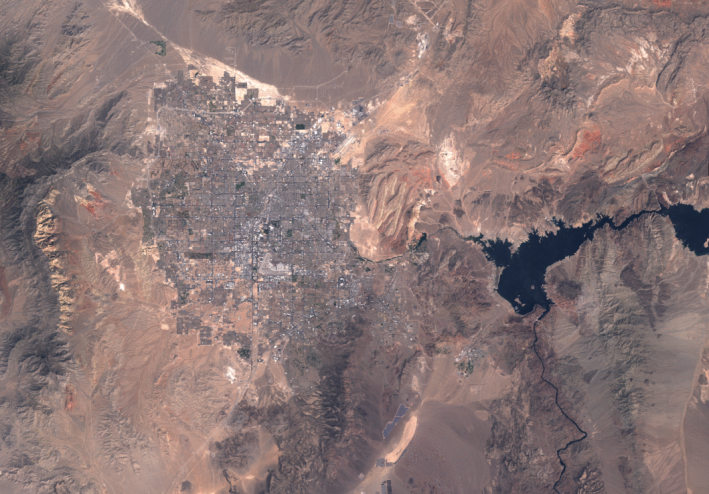
If the environmental impacts from this form of building are so bad, why do we keep doing it? At the risk of sounding conspiratorial, it comes down to money and politics. Powerful groups that have vested interests in expanding the reach of car-dependent sprawl have lobbied aggressively since the genesis of the first interstate highway systems. From the New York Times in 1972:
Since World War II, few special interests have been so spectacularly successful, few pressure groups have had such a secure half nelson on Government expenditures, as the collection of businesses and officials that make up the highway lobby.
The “highwaymen” or “road gang,” as they are called by their detractors, have helped persuade the Federal Government to build the most massive public works program in the nation’s history — the 42,500mile Interstate highway system — at a cost of $60?billion.
And, with the help of their friends in Congress and the executive branch, they have commandeered a special part of Federal revenues — the taxes on gasoline, tires and other items — and arranged for this money to be placed in a special trust fund that is spent only for highways.
Lobbying from car manufacturers has increased meaningfully in the last few decades, with money flowing into various departments of transportation (among other entities) to increase highway funding. Further regulations have been codified through intense lobbying efforts to design streets toward more car-friendly design. Barriers have been erected to make reverting our car dependency nearly impossible, where our world is held hostage to the vested interests of a select few. These interests come at the expense of other modes of transport to make driving as easy as possible.
From the perspective of car makers and the supported industries, this makes sense. The more people have to drive, the more they will spend on the broader ecosystem of cars, regardless of the impact it has. Electric vehicle manufacturers are no exception to this ethic, and have spent generously to advance their agenda (see here for Tesla — whoops). Despite manufacturers public posturing of building towards a more sustainable world, their lobbying dollars tell a different story to enforce and entrench a built environment based on car dependency. This is in direct conflict with their stated positions to be more sustainable!
So long as the system that lobbies for more roads is in tact, we will see precious little reversion of our destructive ways. Electric vehicle manufacturers must say no to highway funding and a continuation of the status quo if they’re truly supportive of a more sustainable future.
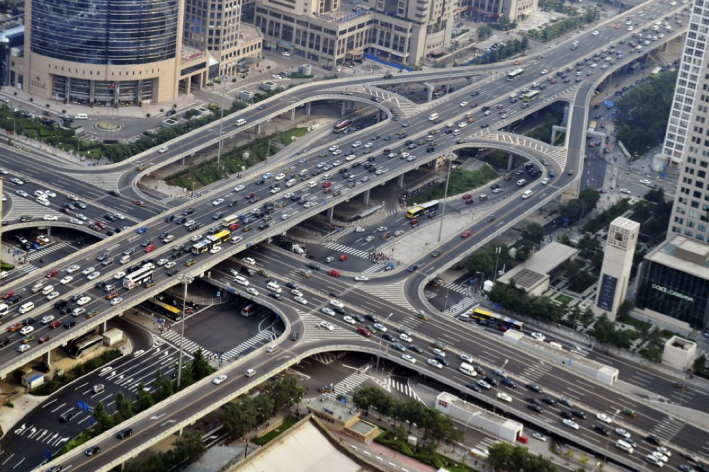
Unfortunately, other countries have followed our poor lead, seduced by the notion that highways are the secret to ascension into relevance and modernity. From Mumbai to Lagos, and Dublin to Dubai, scores of subdivisions have followed the construction of new American-style roads. China, in its ambitions to become the world’s pre-eminent superpower, has built road networks at a scale that dwarves the U.S. system, with land being consumed at a dizzying pace. Unlike America’s low-density suburban sprawl, however, China has drawn inspiration from Corbusieran ideals of super block modernism to create a noxious urban sprawl, bedeviled by pollution and poor air quality. In fully embracing a development pattern that was designed to operate as a machine to streamline car transport, China has failed to learn from the mistakes we so painfully made. But where we stubbornly refuse to move toward a better way, there is at least some momentum in China to rectify its past. It’s setting a better example, better late than never, of sustainable development for others to follow. The U.S. should take note.
Cars v. People: The Continuing Consequences
Let’s for a minute suspend reality and imagine that electric vehicles would, on their own, cure all of the climate issues associated with cars laid out in the previous section. If development patterns extend in a car dependent sprawl, what does it matter if the environmental impact is null? This line of reasoning assumes that the only issue in such a world is the environmental impact. Disastrous as it is, it only tells a part of the story.
Building a world around cars presents many and varied dangers to people. Often cited, but maddeningly still pervasive, cars are exceptionally dangerous pieces of machinery. 1.35 million people around the world die annually in car accidents. This number has hovered around 30,000-40,000 in the U.S. for the past several years. This is unacceptable, but for some reason it’s met by a mix of oh well what can you do’s, and I’m safe, it won’t happen to me’s. Car fatalities are the result of a purely human invention that would not otherwise naturally occur, and continue to rise because we haven’t done anything about it. It cannot be met with the same fatalism as a natural disaster or force majeure. Certainly, no one will be happy if they’re struck by a more sustainable car.
If cars aren’t endangering us through head on collisions or reckless driving, they’re doing so more gradually via routine, but equally devastating consequences. Rates of obesity, diabetes, lung disease (from pollution), heart disease and other afflictions associated with sedentary lifestyles are far higher in car-dependent areas than their walkable/multi-modal counterparts. Public Health notes, “Sprawl significantly predicts chronic medical conditions and health-related quality of life.”
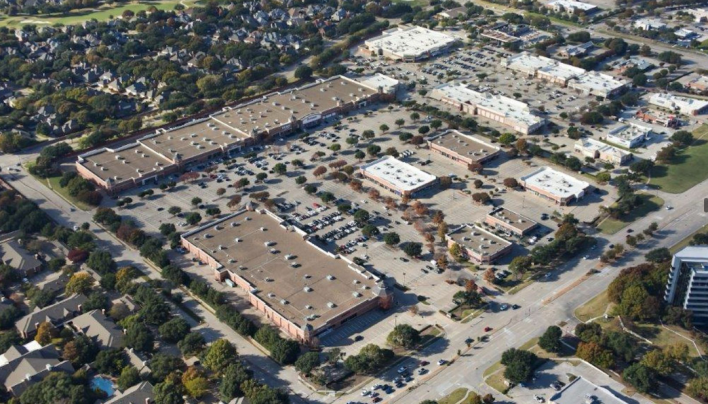
A corollary to the deterioration of our physical health is that of our mental health, which emanates from a fragmented social realm. While midcentury roads severed marginalized communities (who still struggle with the effects today), newly constructed car-dependent development builds in isolation as a feature. When one cannot walk anywhere with intent or for leisure, spontaneous interactions are reduced to near zero. Every engagement and event must become planned, and people develop defensive mentalities. When fences are erected that separate us from our neighbors, togetherness is replaced with “us against the world.” It’s little wonder that homogenization of class and race exists so ubiquitously in such a setup.
Those who cannot drive, or those who cannot afford the expense of owning a car, effectively become second-class citizens in car-dependent places (key word, dependent). This has profound consequences of injustice. To levy a discriminatory participatory tax on those who don’t have the means or the ability to pay is the work of a cruel and morally corrupted system. As the suburbs become poorer in coming decades, this tax will only become more onerous. Many will find themselves trapped without the ability to access opportunities, amenities, or take part in the every day life of their community.
Finally, car dependency destroys the financial security of a place. Just as every further acre of car-dependent development taxes the environment, every acre of low-density, mono-use sprawl strains the finances of municipalities. This is because the tax revenue generated from this type of development doesn’t come close to offsetting the expenses of maintaining it. For example, utility lines shared by 10 people across 100 acres cost far more, net-net, than 100 people on 10 acres. As the imbalance of tax revenue to maintenance expenses grows, the harder it becomes for municipalities to keep up with their bills.
Historically, municipalities have dealt with this imbalance by building more roads, more subdivision communities, and more big box stores, in the hope that these new investments will pay off the old investments (of the very same kind) that failed to generate sufficient revenue. This is the definition of insanity. It’s also a Ponzi scheme. If prevailing development patterns don’t change, we could see many places in the not so distant future fail to uphold their obligations to their residents (clean water, power, education, public safety, etc.) or be forced into bankruptcy.

All of these issues emanate from a series of choices that refuse to consider the complex needs of people, and put them first. Not only do electric vehicles on their own not resolve these many pressing threats, but they accentuate them through a perpetuation of the same failed systems.
Changing development patterns, a better path forward
Cars can be very useful facilitators in our life, but building a society around them has proven to be as disastrous as it is senseless. In case I haven’t hammered the point home yet, allow me an analogy. The way we’ve constructed our society is akin to building homes with all of the nails halfway in, so that the ever-handy hammer can be widely employed. If we didn’t build our society around half-way nailed in structures, a hammer wouldn’t be as ubiquitously necessary. And yet, through a series of policy decisions guided by lobbying dollars and special interest groups, halfway nailed in structures remain despite the obvious dangers such a world poses. More sustainable nails wouldn’t address the totality of the problem. Sounds kind of crazy, right? Well we’ve effectively done the same thing: We’ve created a culture built around necessitating a tool that most effectively works when it comes at the expense of our collective well being.
Operating within the same paradigms, but substituting electric cars for gasoline powered ones, doesn’t change the underlying development pattern based on dependency or all of the consequences that come with it. Instead of moving forward unflinchingly thinking EVs will save us, we have to address the root causes of our unsustainable world.
Yes, we need to invest in sustainable vehicular transport. But we should also be facilitating micro-mobility solutions (like biking, scootering, and mopeding) and the expansion of public transit, all of which can be green and complementary to sound urbanism. More importantly, we must make it possible and safe to walk wherever one needs to. Whether this is through 15-minute city schemes or using tactical urbanism for incremental interventions, there are great precedents we can turn to. But even these solutions fall short, as the fabric of many places cannot easily allow for improvements because they’re affixed to car-dependency. It’s not easy to retrofit a 10-lane highway and a network of six-lane roads, after all.
And so, first and foremost, we need to stop building car-dependent development patterns, wherever they manifest. This can be accomplished by aligning incentives with outcomes. While it might not be possible to make sprawl illegal, we can levy taxes that ensure that developments pay for themselves. If revenues don’t equal expenses, a sprawl tax would be implemented to balance the system. There may not be a single low-density development in America that can do this today, whether it be a power-center strip mall or a 1,000 home subdivision. Once enacted, we would quickly see developers make the decision to stop building these forms, because it would so materially impact their bottom line. Or, they would pay the tax, and the proceeds would go into a special fund dedicated to building better. Subsidizing our destruction must end. In our current socio-economic system, the easiest way to do that is to go after P&L statements, not high morals.
There’s a level of control that extends beyond balance sheets, optimism and naiveté, though, that’s impossible to overturn currently. We must remove money in politics to dismantle lobbying. Not only would it remove influence from the road gang, but also host of other unscrupulous actors. These things are easier said than done, of course, but must be rectified nevertheless.
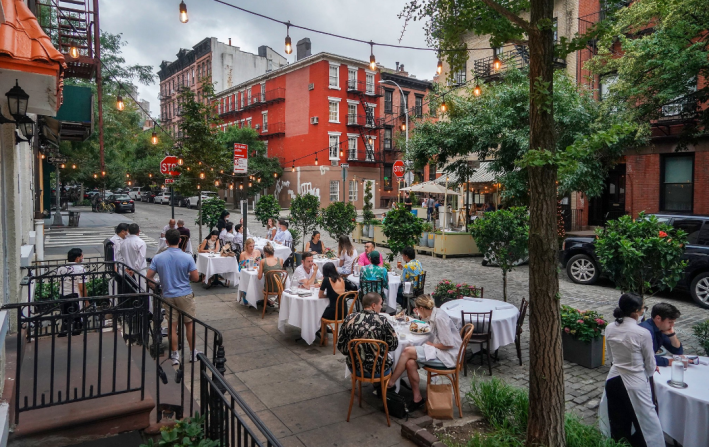
Next, we must begin to retrofit sprawling and car-dependent areas (where possible) to move toward more sustainable development patterns. We can make some progress by up-zoning to accommodate more housing, de-euclidifying mono-use areas to integrate everyday services closer to where people live, and enact road diets that reduce the space for private cars and increase the share for pedestrians, bicyclists and buses. Simply put, we need to build to an urbanist standard. To borrow from Peter Calthorpe:
“Urbanism at its best reduces per capita environmental demands while it makes services, infrastructure, and economic development more efficient, more cost-effective, more accessible, and more interconnected.”
Finally, for new greenfield developments, we need to fundamentally re-organize our land-use planning and zoning classifications to allow for the types of places that are the most sustainable and offer the highest possible quality of life. Put differently, we must allow people to build actual towns, not segregated, car dependent amalgams of strip malls and subdivisions. These would likely be composed of small blocks of fine grained urbanism built around people first, not vehicles. This scale works at 500 or 500,000 people. By clustering development close together, we can preserve our rural land from deforestation, miles of paved surfaces, and the loss of natural ecosystems. We need look no further to English country towns or Italian villages for inspiration on how to create these types of places.
All of these interventions must be predicated on using sustainable technologies and standards to make meaningful progress toward cutting our emissions. For example, Passive house, an exacting standard for energy efficiency, holds promise for creating structures that operate with near net-zero emissions. They can be designed to look no different than their more carbon-philic counterparts. Through stronger standards on building operations, and an emphasis on the reduction of overall embodied carbon, we’ll be moving ever closer to the emissions reductions thresholds we must hit if we’re to avoid the most catastrophic climate scenarios. Perhaps these can be the aspirational modes of living for tomorrow, and we arrive at sustainability through status seeking, instead of purely moralistic posturing. Indeed, people won’t pay more for something that’s sustainable purely because it is so, they need to value the product in its own right.
I’m fearful we’re not doing nearly enough nor moving as fast as we need to in order to stave off the most dire scenarios of climate change. While switching to electric vehicles is a step in the right direction, it’s only just a step. We have a chance for meaningful change, but we need to be bold enough to do it.
The construction of our world is the result of a series of conscious choices that have created how and where we live today. While this has been woeful for nearly the last century, it doesn’t need to be. We can consciously create better places at a large scale, and we don’t have to wait. It’s time to build a more sustainable world. A smarter world by going back to what’s worked for centuries. It’s time to build for people first.
Coby Lefkowitz is passionate about cities and the potential to create better places at the intersection of Real Estate Development & Urban Planning. Twitter: @cobylefko.
